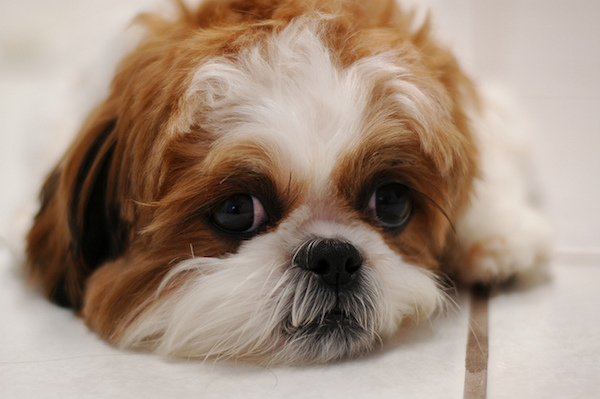From hunters to cherished companions, the role of the canine in Korean culture has transformed radically

By Michelle Woo
Photograph by Grace Chon
Once upon a time, Koreans believed a dog was just a dog.
The four-legged creature lived in the confines of the backyard; his filthy paws were never to step foot onto Mom’s just-waxed marble floor. His meals consisted of leftover scraps from dinner. His job was simple: to protect the home.
He was a dog. He lived a dog’s life.
And then we cracked.
Amy Chung, an attorney in Washington, D.C., recently cut out pictures of her dogs’ faces and attached them to popsicle sticks so that they—or at least their photographs—could be part of her out-of-state wedding. Helena Sung, a writer in New York City, serves only organic boneless chicken, veggies and brown rice to her pooch, Jasper. Eileen Song, an accountant in San Francisco, has purchased more than 50 different outfits for her posh pup, along with hats, jeweled collars and a pink backpack personalized with her name, Snowball Song. Liz Paik and her husband take separate vacations so someone can always be home with their tailed pal, Abigail.
“My life revolves around the dogs,” says Chung, mama to Kota, a cream-furred Shiba, and now Juneau, her fiancé’s 60-pound husky. “All my conversations are about them. I’ll be like, ‘Kota hasn’t being going No. 2’ and the person I’m talking to will be like, ‘Gross. Why are you telling me this?’”
From a cheap security alarm system to our greatest companion, the role of the domestic dog in Korean and Korean American culture has evolved—and to an extreme. In South Korea, Dog Mania is in full force as proud owners tote little Fido—or, more accurately, “Bokshiri” or “Mandu”—to dog cafés, designer dog boutiques and dog salons (one fashion trend is to have those floppy dog ears dyed pink, purple or green). According to a report on the Korean broadcasting network Arirang TV, the number of pets in the country jumped to 3.5 million from 2.7 million in 2000. Sorry, felines, it’s a canine nation: 90 percent of house pets in Korea are dogs and only 5 percent are cats.
Historically, dogs in Korea were bred and raised to be hunters, protectors of military bases or family watchdogs. Those that could not be sold became—gulp—dog meat. But as Koreans became more prosperous, and more influenced by Western culture, they began to see the dog as more than just a dog. “Those from war-torn Korea didn’t have enough to feed their families, let alone dogs,” says Grace Chon, a Los Angeles-based professional pet photographer. “Now that we have the opportunity to have dogs as pets, we treat them as family members.”
Older generations in the United States are also nuzzling up to this modern view, albeit slowly. According to the humor site Stuff Korean Moms Like, Korean matriarchs are conditioned to abhor the idea of indoor pets. “Pet fur to a Korean Mom is like what water was to the Wicked Witch in Oz,” one blog entry reads. But once they do let a dog into their home—often at the insistence of their children or friends—they fall in love.
One day, Na Young Ma and her sister brought home a rescue dog, knowing that their 60-year-old mother, who’d always been afraid of animals, would probably freak out. She did, but she let the Pomeranian mix stay. Ma then witnessed the transformation.
“It was a little weird,” says Ma, a baker in Glendale, Calif. “She slowly turned around and even got another dog from her friend. Now she’s a crazy dog person. She’s truly gone over the edge. It’s quite embarrassing. She talks to the dogs, cleans their feet after each walk and tucks them in with a blanket on the couch. She always says ‘bulsanghae,’ like ‘You poor little thing.’ We joke that she never gave us that much attention when we were kids.”
Koreans tend to gravitate toward small, fluffy, yappy dogs—the Maltese, Yorkie, Chihuahua, Shih Tzu and Pomeranian are some of the most sought-after breeds. The hypotheses explaining this are plenty: Asians are smaller in stature so they can better handle these miniature mammals; people in Korea live in apartments that don’t allow for large animals; Korean girls love purses and want breathing accessories to fit inside. And, of course, there’s the adorable factor. “Asians in general have a fascination with cute things, like Sanrio characters,” Chon explains. “Their love for small breeds might be an extension of that.”
The popularity of these pint-sized pups has led to an explosion of Korean-owned pooch stores in Los Angeles Koreatown and beyond. Many concentrate in specialty dogs that are either toy- (typically 4 to 7 pounds) or teacup-sized (less than 4 pounds). Christine Shin sells these mini-creatures at her shop, Toto Puppies in Torrance, Calif. Her bestseller is the toy Yorkie, priced at about $2,500, though she says Korean customers prefer the “clean and white” look of the Maltese. “They don’t shed as much,” she says in Korean.
But Andrew Kim, owner of the upscale dog shop Healthy Spot, with locations in Santa Monica and West Hollywood, Calif., says people should think twice before purchasing an unusually tiny canine. “When they’re bred to be small, they often have health issues. They’re fragile and their immune systems may be compromised. They often come from puppy mills or backyard breeders,” he says, adding, “Dogs and cats [in shelters] are being put to sleep. I don’t see why people need a pocket pug [from a breeder] to carry in their handbag.”
Kim is the owner of an adopted Shih Tzu mix named Maya, and advocates pet adoption. That’s just how Helena Sung got her dog, Jasper. Since she couldn’t find a small dog to adopt locally (they’re in high demand in New York), she flew to Detroit, rented a car and drove to a small town in Ohio to meet her new pooch, a black and white Yorkshire terrier mix with raccoon-like spots around his eyes. “As soon as he was in my arms, he started licking my face,” Sung says. “It was love at first sight.”
Now Sung says she can’t imagine life without him. “Even if I’ve only been gone for 15 minutes, whenever I come back to the apartment, he greets me like he hasn’t seen me in years, jumping on me and giving me kisses,” says Sung, who covers pet news for Examiner.com. “He doesn’t care that there are other people in this world who are richer, skinnier or better-looking—he loves me best.”
Love stories are everywhere. “I never thought I could be so attached to anything,” says Esther Yum, a tutor in San Jose, Calif., of her Maltipoo (a Maltese and Poodle mix) Rocco, whom she describes as “a little bear.” “He has changed my family. Everyone seems happier.”
Says Hyungwon Kang, a photojournalist in Washington, D.C., and an expert on the Korean Jindo breed: “Korean Americans love dogs more than they love people. And rightfully so. Children brought up with dogs have a higher sense of self-esteem because of their experience with unconditional love. It’s the only way to grow up.” He adds, with a laugh, “I’ve heard that a person’s blood pressure is lowest when they’re with a dog—and highest when they’re with their spouse!”
And when dogs pass away, the loss can be devastating. June Kim, a designer in Pasadena, Calif., had her Maltese, Curi, for 13 years before it died of a heart problem three years ago. “It was so hard not being able to hear her play around the house anymore,” she says. “I couldn’t sleep. I’d wake up at 3 a.m. every night. I lost 15 pounds.” Kim has another Shih Tzu named Tori, who is 17 years old, and now deaf and blind. Kim says she’s her “No. 1 companion.” “When she dies, I don’t know if I’ll ever be able to love another dog again.”
This fear of loss will drive humans to go great lengths to save their old or sick pups. (Note for those without pets: Veterinary medicine is notoriously pricey, though pet health insurance exists.) Recently, when a veterinarian found a cantaloupe-sized tumor inside Amy Chung’s fiancé’s dog, Juneau, the couple was told that surgery to remove it would cost $3,000, not including fees for the tests and X-rays. Without much hesitation, the couple put it on their credit card. “It’s crazy to see how far we’ll go for a dog,” Chung says.
Perhaps this is the main distinction between those with dogs and those without. Many dog owners—regardless of ethnicity or culture—can’t imagine daily life without their furry beasts, even going so far as to view them as extensions of themselves. A dog isn’t just a dog, but for some, a family member, companion or dependent who loves unconditionally. Similar to having a child, having a dog changes lives—often, in surprising and significant ways.
Chung says that having her dog, Kota, made her a better person. “That’s why I got a dog—I was way too selfish,” she says. “I would spend too much money and buy shoes I didn’t need. I wanted to think of something other than myself. Kota has made me more responsible. He’s my priority.”







